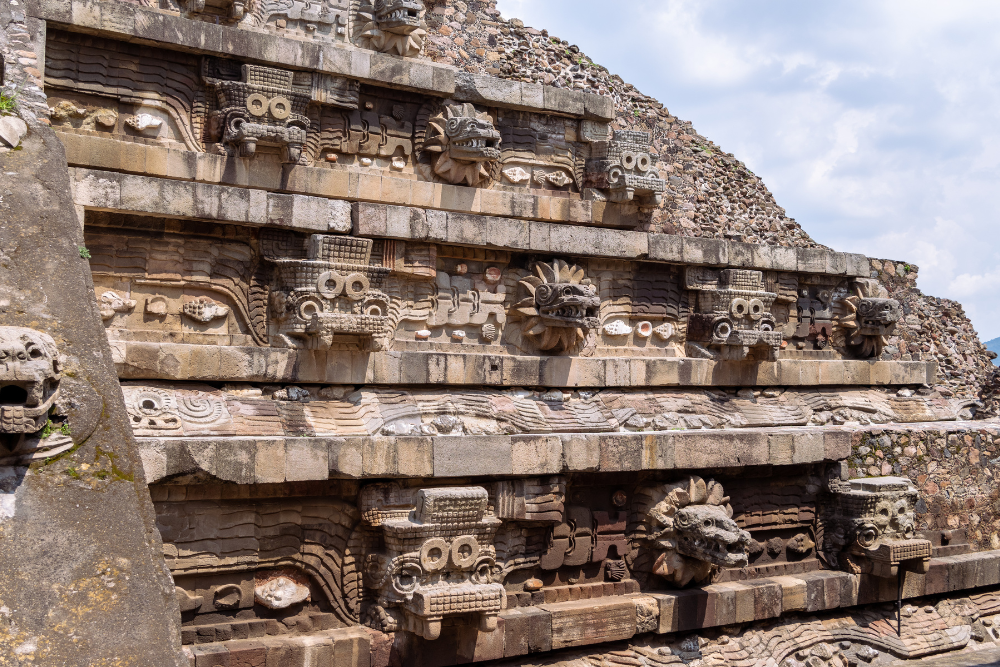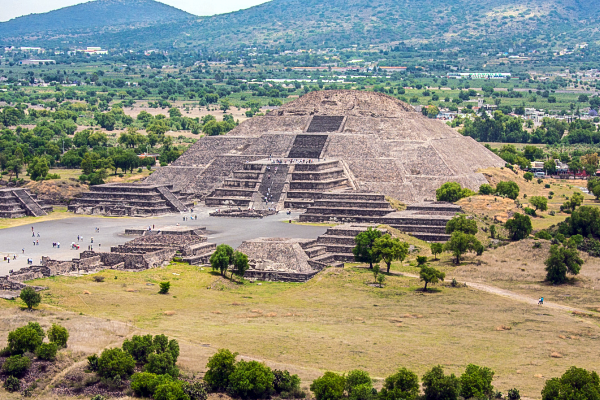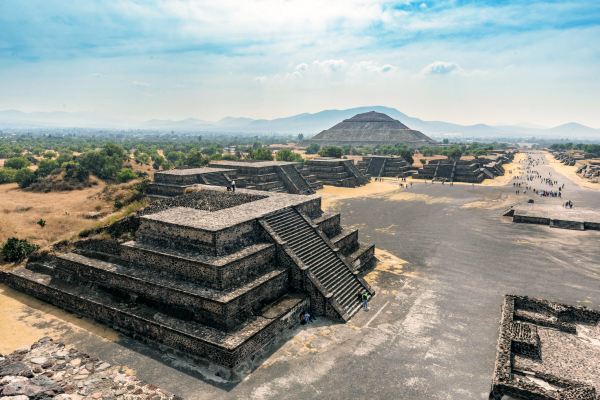MEXICO
Exploring Teotihuacán
By Chance Nalley, Davis Church, Joao Gasparian, Roshan Gopal, Varun Gupta, Shaye Kirman, Thierry Lawrence, Evan Song, Jagger Stachtiaris, and Derek Tang
New York City, NY, United States
In the heart of modern-day Mexico lies the awe-inspiring archaeological site of Teotihuacán, an ancient Mesoamerican city that flourished between the first and seventh centuries CE. Just over an hour’s drive from Mexico City, it stands as a testament to the ingenuity and advanced knowledge of its architects and engineers.
Designated as a UNESCO World Heritage Site in 1987, Teotihuacán covers an area of approximately 36 square kilometers (13 square miles). More than 200,000 residents may have lived there during its peak in the middle of the first millennium CE. Its size made it one of the most influential Mesoamerican cities of its time and among the largest population centers in the ancient world.
Precision Cityscape
Teotihuacán’s urban layout boasts practicality and precision. The city features a grid system and a standard unit of measurement. The central Avenue of the Dead, stretching about four kilometers (2.5 miles) is flanked by monumental structures arranged along cardinal directions. This intentional design, intersected by straight streets, highlights the city’s advanced engineering and thoughtful organization.
Teotihuacán’s builders were keen astronomers. For example, the Avenue of the Dead is oriented about 15.5 degrees east of true north, suggesting astronomical and calendrical significance. The majestic Pyramid of the Sun in the city’s central complex aligns with sunrises and sunsets on significant dates. Ranked as the third-largest pyramid in the world, it commands attention with a height of 65 meters (m), or 213 feet (ft.), and a base of approximately 225 m (738 ft.) on each side.

At one end of the Avenue of the Dead, the Pyramid of the Feathered Serpent, also known as the Temple of Quetzalcoatl, is adorned with intricately carved stone serpent heads. It stands 20 m (66 ft.) tall, with a base area of 130 square meters, and is the third-largest pyramid in the city. At the other end of the avenue, the colossal Pyramid of the Moon adds to the collection of monumental structures in Teotihuacán, standing proud at a height of approximately 43 m (141 ft.) with a base that measures 147 m (482 ft.) by 130 m (426 ft.).
Water Works
The city had an elaborate water drainage and supply system, with canals and wells providing water to its sizable population, especially important in an arid climate. Scholars debate reasons for the deliberate diversion of the nearby San Juan River, but it makes two nearly right turns to conform to the city’s grid. The significance attributed to water went beyond mere practicality, extending to religious dimensions that underscored its central role in the cultural fabric of Teotihuacán.
Abandonment
Despite its grandeur, Teotihuacán witnessed a population decline. By the eighth century CE, it was abandoned, leaving an enigmatic legacy. Yet, we can still appreciate the ancient engineering minds that fused mathematics, engineering, and astronomy to shape an unparalleled cultural treasure.
Have a suggestion for this story? We’d love for you to submit it!


Blank
Blank
Math Resources
Sample Problems for Elementary School:
- How long has Teotihuacán been a UNESCO World Heritage site? (Grades 1–2)
- Your driveway is 0.5 kilometers long. How much longer is the Avenue of the Dead? (Grade 2)
- What is the perimeter of the base of the Pyramid of the Sun? What is the perimeter of the base of the Pyramid of the Moon? (Grade 3)
- Estimate the average number of inhabitants per square kilometer in Teotihuacán. How does that compare to the average number of inhabitants per square kilometer in your community? (Grade 4)
- Your class wants to visit all four of the main pyramids in any order. How many ways are there to do this? (Grades 3–5)
Sample Problems for Middle School:
- What is the total land area the three pyramids take up? (Grades 5–6)
- New pyramids have been added to Teotihuacán, and your class wants to visit them in any order. How many ways are there to do this if there are 5, 6, 8, 10, or 100 pyramids? (Grades 7–8)
- What is the approximate volume of the Pyramid of the Feathered Serpent? (Grade 7)
- Estimate the volume of the Pyramid of the Sun. Why can’t we calculate the exact volume of any Teotihuacán pyramid with the given information? (Grade 7)
- What is, approximately, the ratio of the volumes of the three pyramids? How does that number compare to the ratio of heights, lengths, and widths? (Grade 7)
- Teo and Huacán are walking one day when Teo asks Huacán to guess two numbers he is thinking of. Teo gives two hints:
- The sum of my numbers is the height of the Pyramid of the Moon.
- Both of my numbers are prime.
- What is the product of Teo’s two numbers? (Grade 7)
Sample Problems for High School:
- If each dimension of the Pyramid of the Feathered Serpent were increased by x meters, estimate the total increase in volume in terms of x.
- You are standing in the Avenue of the Dead, which is approximately 15 degrees east of true north. Your friend Alice stands 2 km away on an easterly street perpendicular to the Avenue of the Dead. Your backpack is located 2 km away from where you are, on the Avenue of the Dead, in a northerly direction. Your friend Bob is standing true north of you such that Bob, Alice, and your belongings form a straight line. How far is Bob from your backpack? (Grades 8–10)
- How far north does the Avenue of the Dead stretch?
- What, approximately, is the angle of elevation for the Pyramid of the Feathered Serpent?
- The great Pyramid of the Sun has a height of 65 m and a base of 225 m per side. The top of the pyramid is colored blue and is 50 m off the ground. If this blue part were to be separated, it would form a pyramid as well. What is the area of the pyramid that is not colored blue?
- Estimate the two angles of elevation of the colossal Pyramid of the Moon (consider two adjacent sides).
- The Avenue of the Dead is located about 15.5 degrees east of true north. If every day since it was constructed on January 1, 200 CE, the street shifts another 15.5 degrees clockwise, what direction between 0° and 360° will it be on May 5, 2030?
Social Justice Question
- What is a UNESCO World Heritage Site? Who should be responsible for paying for the maintenance of such sites? Who should have access to these sites? If providing access to the sites provides income for locals but damages the sites, what should authorities do?
- Teotihuacán was built and inhabited during the “pre-Columbian” or “pre-Hispanic” period of the Americas. What is the significance of labeling this era “pre-Columbian” or “pre-Hispanic”?
- Research the world’s largest cities in the year 500 CE. Are they still among the largest? What do you think will happen to today’s largest cities? Explain your reasoning.
Explore Further
- UNESCO World Heritage Site’s webpage about Teotihuacan
- Images of Teotihuacan’s architecture and artifacts
- More information about Teotihuacan’s use of astronomy and mathematics
- Drone views of Teotihuacan
Share Your Story
Write your own Global Math Story and send it to us!
Sorry, the comment form is closed at this time.